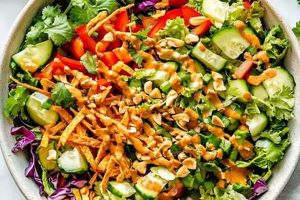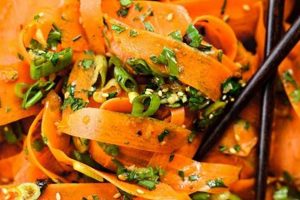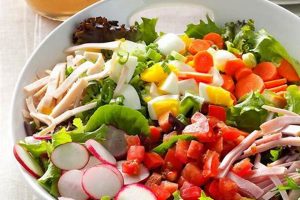A dish inspired by the Greek tradition of cooking meats over an open fire, this culinary creation typically features grilled proteins, often pork or chicken, combined with fresh, vibrant ingredients like tomatoes, cucumbers, red onion, and herbs. A lemon-herb vinaigrette or a creamy yogurt-based dressing often complements the savory flavors of the meat and the crispness of the vegetables. Variations can include the addition of feta cheese, olives, or other regional ingredients. An example might involve marinated chicken thighs grilled and served alongside a salad of chopped romaine, tomatoes, cucumbers, red onion, and a lemon-oregano dressing.
The appeal of this type of dish lies in its balance of flavors and textures. The smoky char of the grilled meat provides a savory depth, while the fresh vegetables offer a refreshing counterpoint. The acidic brightness of the dressing ties the elements together, creating a harmonious and satisfying meal. Historically, grilling meats over an open flame has been a central practice in Greek cuisine, reflecting a connection to both communal gatherings and simple, wholesome ingredients. This dish offers a contemporary interpretation of that tradition, adapting it for modern kitchens and palates.
The following sections will explore variations on this culinary theme, offering detailed guidance on ingredient selection, marinade preparation, grilling techniques, and dressing recipes. Whether seeking a light lunch, a flavorful dinner, or a dish to share at a gathering, the possibilities within this culinary framework are vast and inviting.
Tips for an Exceptional Grilled Salad
Achieving optimal results requires attention to detail throughout the preparation and cooking process. The following tips offer guidance for maximizing flavor and presentation.
Tip 1: Marinate the Protein: Marinating the meat for at least two hours, or preferably overnight, allows the flavors to penetrate deeply, resulting in a more tender and flavorful finished product. A simple marinade of olive oil, lemon juice, garlic, and oregano is a classic choice.
Tip 2: Optimal Grilling Techniques: Grilling over medium-high heat allows for proper searing and charring while preventing the meat from drying out. Ensure the grill grates are clean and oiled to prevent sticking.
Tip 3: Vegetable Selection and Preparation: Choose fresh, seasonal vegetables for optimal flavor and texture. Consider grilling some of the vegetables, such as bell peppers or onions, to add a smoky dimension to the salad.
Tip 4: Balancing Flavors with the Dressing: The dressing should complement the flavors of the grilled meat and vegetables without overpowering them. A bright vinaigrette or a creamy yogurt-based dressing can provide a refreshing counterpoint to the richness of the grilled elements.
Tip 5: Proper Resting Time: Allow the grilled meat to rest for a few minutes before slicing or chopping. This allows the juices to redistribute, resulting in a more tender and flavorful final product.
Tip 6: Presentation Considerations: Arrange the salad components thoughtfully for an appealing presentation. Consider adding a sprinkle of feta cheese, Kalamata olives, or fresh herbs as a finishing touch.
By following these guidelines, one can elevate this simple dish to a culinary experience that showcases the harmonious blend of fresh, vibrant flavors and satisfying textures.
The following section will offer concluding thoughts on the versatility and appeal of this dish, along with suggestions for variations and accompaniments.
1. Grilled Meat (Souvla)
Grilled meat, or souvla, forms the cornerstone of a souvla salad recipe. The term “souvla” itself refers to large pieces of meat cooked on a long skewer over an open flame, a traditional method of Greek cooking. This grilling process imparts a distinctive smoky flavor and char to the meat, which significantly influences the overall character of the salad. The choice of meat, typically pork, chicken, or lamb, affects the final taste profile. Pork offers rich, savory notes, while chicken provides a milder, more versatile base. Lamb contributes a gamey flavor profile. The quality of the meat and the marinade used further impact the finished dish. For instance, high-quality, free-range chicken marinated in lemon, garlic, and oregano will yield a more flavorful and tender result compared to conventionally raised chicken with a simpler marinade.
The grilling method itself contributes significantly to the texture and taste of the souvla. Grilling over high heat creates a crisp exterior while maintaining a juicy interior. The Maillard reaction, a chemical process occurring during grilling, contributes complex flavors and aromas. Achieving the proper balance of char and tenderness is crucial. Overcooked souvla becomes dry and tough, while undercooked meat lacks the desired smoky flavor. For example, properly grilled pork souvla will exhibit a beautiful char on the outside while remaining succulent and juicy within. This textural and flavor contrast enhances the salad’s overall appeal.
Understanding the crucial role of souvla provides a foundation for crafting a successful souvla salad recipe. The chosen meat, marinade, and grilling technique directly influence the final dish’s flavor profile and textural complexity. Mastery of souvla preparation ensures a balanced and satisfying culinary experience, highlighting the interplay between the grilled meat and the fresh salad components. The careful selection and preparation of the souvla elevates the salad beyond a simple combination of ingredients, transforming it into a cohesive and flavorful culinary creation.
2. Fresh Vegetables
Fresh vegetables play a crucial role in a souvla salad recipe, providing a refreshing counterpoint to the richness of the grilled meat. Their vibrant colors, crisp textures, and diverse flavors contribute significantly to the overall sensory experience. Careful selection and preparation of these components are essential for a well-balanced and appealing salad.
- Variety and Seasonality
A diverse selection of vegetables enhances both the nutritional value and the aesthetic appeal of the salad. Prioritizing seasonal produce ensures optimal flavor and freshness. Tomatoes, cucumbers, red onion, and bell peppers are common inclusions, offering a mix of sweet, tangy, and savory notes. Seasonal additions, such as asparagus in spring or roasted squash in autumn, can further elevate the salad’s complexity.
- Textural Contrast
The textural interplay between the grilled meat and the fresh vegetables is a defining characteristic of a successful souvla salad. Crisp vegetables, like romaine lettuce, cucumbers, and bell peppers, provide a satisfying contrast to the tender, often charred, meat. This textural diversity enhances the enjoyment of each bite. Incorporating elements like crumbled feta cheese or toasted nuts can further amplify this contrast.
- Flavor Balancing
The inherent flavors of the chosen vegetables contribute to the overall balance of the salad. The acidity of tomatoes, the coolness of cucumbers, and the sharpness of red onion cut through the richness of the grilled meat, creating a harmonious flavor profile. Incorporating herbs, such as fresh parsley, dill, or mint, can further enhance the aromatic complexity.
- Preparation Techniques
Proper preparation techniques are essential for maximizing the flavor and texture of the vegetables. Washing and drying produce thoroughly ensures optimal crispness. Chopping vegetables into uniform sizes facilitates even distribution within the salad and enhances presentation. Grilling certain vegetables, like bell peppers or zucchini, can impart a smoky char that complements the grilled meat.
The interplay of these facetsvariety, texture, flavor, and preparationdemonstrates the integral role fresh vegetables play in a souvla salad recipe. Their inclusion elevates the dish beyond simply grilled meat and greens, transforming it into a multi-dimensional culinary experience. The careful consideration of these elements ensures a balanced, flavorful, and visually appealing salad that complements the rich, savory notes of the souvla.
3. Vibrant Dressing
A vibrant dressing is essential to a successful souvla salad recipe, acting as a unifying element that harmonizes the flavors of the grilled meat and fresh vegetables. The dressing contributes not only flavor but also texture and visual appeal, elevating the dish beyond a simple combination of ingredients. Its careful selection or preparation is crucial for a balanced and satisfying culinary experience.
- Acidity and Brightness
Acidity is a cornerstone of a vibrant dressing, providing a necessary counterpoint to the richness of the grilled meat. Lemon juice, red wine vinegar, or a combination thereof, are common acidic components. This brightness cuts through the fattiness of the souvla, preventing the salad from feeling heavy or overly rich. For example, a lemon-herb vinaigrette provides a refreshing lift to grilled chicken or pork. The level of acidity should be carefully calibrated to complement, not overpower, the other flavors.
- Flavor Complexity
Beyond simple acidity, a vibrant dressing offers layers of flavor that enhance the overall complexity of the salad. Fresh herbs, such as oregano, dill, or mint, contribute aromatic notes. Garlic, shallots, or Dijon mustard add pungent accents. A touch of sweetness, from honey or a small amount of sugar, can balance the acidity and round out the flavor profile. For instance, a dressing incorporating lemon juice, oregano, garlic, and a touch of honey creates a nuanced flavor profile that complements grilled lamb.
- Texture and Emulsification
The texture of the dressing also contributes to the overall sensory experience. A vinaigrette, with its light and slightly acidic character, offers a refreshing contrast to the other components. A creamy dressing, perhaps yogurt-based, provides a richer, more substantial element. Proper emulsification, the process of combining oil and an acidic liquid into a stable mixture, is crucial for a smooth and cohesive dressing. A well-emulsified vinaigrette clings lightly to the salad ingredients, ensuring even distribution of flavor.
- Visual Appeal
The visual appeal of the dressing should not be overlooked. A vibrant color, derived from ingredients like fresh herbs, spices, or even a touch of tomato paste, enhances the overall presentation of the salad. The dressing should complement the colors of the other components, creating a visually harmonious dish. A brightly colored lemon-herb vinaigrette, for instance, enhances the visual appeal of a salad featuring grilled chicken, tomatoes, and cucumbers.
The interplay of acidity, flavor complexity, texture, and visual appeal demonstrates the significant role a vibrant dressing plays in a souvla salad recipe. It is not merely a condiment but an integral component that elevates the dish to a new level of culinary sophistication. The careful consideration of these elements ensures a balanced, flavorful, and visually appealing salad that complements the savory notes of the souvla and the freshness of the vegetables.
4. Authentic Greek Flavors
Authentic Greek flavors are integral to a true souvla salad recipe, distinguishing it from mere grilled meat salads. These flavors, derived from specific ingredients and culinary traditions, contribute significantly to the dish’s identity and overall sensory experience. The connection between these flavors and the souvla salad rests on a foundation of culinary heritage and the careful selection of components that evoke the essence of Greek cuisine. A key element is the use of high-quality olive oil, a staple of the Mediterranean diet and a foundational ingredient in Greek cooking. Its rich, fruity flavor permeates the salad, enhancing the other components. Fresh herbs, such as oregano, mint, and dill, play a crucial role, contributing aromatic complexity and a refreshing herbaceousness. Lemon, with its bright acidity, cuts through the richness of the grilled meat and adds a characteristic citrusy note. Garlic, often used in marinades and dressings, provides a pungent savory depth. These core ingredients, combined in specific ways, create a flavor profile that is distinctly Greek.
The concept of authenticity extends beyond individual ingredients to encompass traditional culinary techniques. Marinating the meat in a mixture of olive oil, lemon juice, garlic, and herbs is a hallmark of Greek cooking. This process not only tenderizes the meat but also infuses it with authentic flavors. Grilling the meat over an open flame, reminiscent of traditional souvla preparation, further enhances the authenticity of the dish, imparting a smoky char and enhancing its flavor profile. For example, a souvla salad featuring pork marinated in lemon, garlic, and oregano, grilled and served with a salad dressed in a lemon-herb vinaigrette, embodies these authentic Greek flavors. A salad using a different type of oil, alternative herbs, or a bottled dressing, while potentially tasty, would lack the same level of authenticity.
Understanding the significance of authentic Greek flavors in a souvla salad recipe is essential for appreciating the dish’s cultural context and achieving its intended flavor profile. These flavors, derived from specific ingredients and traditional techniques, contribute significantly to the salad’s identity and overall enjoyment. Recreating these flavors requires careful attention to detail and a commitment to using high-quality ingredients. While variations are possible, adhering to the core principles of Greek cuisine ensures a truly authentic and satisfying culinary experience. This understanding provides a foundation for appreciating the nuances of Greek cuisine and its influence on contemporary dishes like the souvla salad.
5. Balanced Textures
Textural balance is a defining characteristic of a well-executed souvla salad recipe, elevating it from a simple combination of ingredients to a multi-dimensional culinary experience. This balance stems from the interplay between the tender, often charred, grilled meat and the crisp, fresh vegetables. The contrast in textures provides a dynamic element, engaging the palate with a variety of sensations in each bite. The succulent interior of properly grilled souvla, juxtaposed with the crisp snap of fresh cucumbers or the juicy burst of tomatoes, creates a harmonious textural profile. This interplay prevents the salad from feeling monotonous, ensuring a stimulating and satisfying dining experience. Consider, for example, the difference between a souvla salad with crisp romaine lettuce versus one with wilted or soggy greens. The crisp lettuce provides a refreshing counterpoint to the rich meat, while the wilted greens would result in a less appealing, texturally homogenous dish. This contrast extends beyond the core components. The potential addition of crumbled feta cheese introduces a creamy, salty element, further diversifying the textural landscape. Toasted nuts or seeds can contribute a satisfying crunch, while a sprinkle of fresh herbs offers a delicate, leafy texture. Each additional element plays a role in the overall textural balance, adding layers of complexity to the dish.
The practical significance of understanding textural balance in a souvla salad recipe lies in its impact on both enjoyment and satiety. The variety of textures stimulates the palate, making the eating experience more engaging and preventing palate fatigue. Furthermore, this balance contributes to a feeling of fullness and satisfaction. The combination of protein, fiber, and healthy fats, coupled with the textural diversity, creates a more substantial and satisfying meal compared to one with a uniform texture. This understanding allows for informed choices regarding ingredient selection and preparation methods. Choosing fresh, crisp vegetables and ensuring the souvla is grilled to the proper doneness are crucial steps in achieving the desired textural balance. Additionally, considering the textural contributions of each ingredient, from the dressing to optional additions like feta or nuts, allows for a more nuanced and deliberate approach to recipe development. This understanding empowers one to craft a souvla salad that is not only flavorful but also texturally dynamic and satisfying.
Achieving a balanced textural profile in a souvla salad recipe is crucial for maximizing both enjoyment and satisfaction. This balance, derived from the interplay of tender grilled meat and crisp fresh vegetables, elevates the dish from a simple combination of ingredients to a more complex and engaging culinary experience. Understanding the role of texture and employing appropriate preparation techniques allows one to create a souvla salad that is not only flavorful but also texturally stimulating and deeply satisfying. This principle of textural balance extends beyond the souvla salad, offering a valuable framework for approaching a wide range of culinary creations. The interplay of textures is a key element in creating dishes that are both delicious and engaging, enhancing the overall dining experience. This understanding empowers both home cooks and culinary professionals to craft dishes that are not only flavorful but also texturally dynamic and satisfying.
6. Simple Preparation
The relative simplicity of preparation is a key aspect of the souvla salad recipe, contributing to its widespread appeal and adaptability. While achieving optimal flavor requires attention to detail, the overall process remains straightforward, making it accessible to cooks of varying skill levels. This simplicity does not equate to a lack of sophistication; rather, it highlights the dish’s focus on fresh, high-quality ingredients and straightforward cooking techniques. The following facets explore the components of this simplicity and its implications for the souvla salad recipe.
- Minimal Pre-cooking Steps
The souvla salad recipe typically involves minimal pre-cooking. While marinating the meat is often recommended, it requires little active time. The vegetables typically require only washing and chopping. This minimal preparation contrasts with more complex recipes involving multiple sauces, elaborate pre-cooking steps, or intricate assembly. For example, compared to a dish requiring a roux-based sauce or a multi-step braise, the souvla salad demands significantly less preparation time. This allows cooks to focus on ingredient quality and grilling technique rather than complex pre-cooking procedures.
- Straightforward Cooking Techniques
Grilling, the primary cooking method for the souvla, is a relatively straightforward technique. While mastering grilling requires practice, the basic process of cooking meat over an open flame is accessible to most. Similarly, preparing the salad components involves basic knife skills and requires no specialized equipment. This simplicity contrasts with dishes requiring techniques like sous vide cooking or complex pastry work. The straightforward nature of the cooking techniques allows the flavors of the ingredients to shine through without being masked by elaborate preparations.
- Adaptability and Flexibility
The simplicity of the souvla salad recipe allows for considerable adaptability. The choice of meat, vegetables, and dressing can be easily adjusted to accommodate personal preferences and seasonal availability. This flexibility extends to portioning and serving; the salad can be served as a light lunch, a hearty main course, or a component of a larger meal. For instance, a cook could substitute chicken for pork, use seasonal vegetables like asparagus or zucchini, and opt for a yogurt-based dressing instead of a vinaigrette. This adaptability makes the recipe versatile and suitable for a variety of occasions.
- Emphasis on Fresh Ingredients
The simple preparation of the souvla salad underscores the importance of fresh, high-quality ingredients. Because the cooking techniques are straightforward, the flavors of the ingredients are prominent. Using fresh, seasonal produce and high-quality meat significantly impacts the final dish’s overall quality. For example, using ripe, in-season tomatoes will result in a more flavorful salad than using out-of-season or less flavorful varieties. This emphasis on fresh ingredients aligns with the principles of Mediterranean cuisine, which prioritizes simple preparations that highlight the natural flavors of high-quality produce.
The simplicity of preparation in a souvla salad recipe is not a compromise but rather a conscious choice that emphasizes fresh ingredients and straightforward cooking techniques. This approach allows the inherent flavors of the components to shine through, resulting in a dish that is both satisfying and relatively easy to prepare. This simplicity, combined with the adaptability of the recipe, contributes to its enduring popularity and its suitability for a wide range of culinary contexts. The ease of preparation allows cooks to focus on selecting high-quality ingredients and mastering fundamental cooking techniques, resulting in a dish that is both flavorful and accessible.
Frequently Asked Questions
This section addresses common inquiries regarding the preparation and enjoyment of souvla salad recipes.
Question 1: What is the traditional meat used in souvla?
Traditionally, pork is the most common meat used for souvla. However, chicken and lamb are also popular choices, each offering a distinct flavor profile. The selection often reflects regional preferences and ingredient availability.
Question 2: Can the meat be cooked in an oven instead of grilled?
While grilling over an open flame imparts a characteristic smoky flavor, oven-roasting is a viable alternative, especially when outdoor grilling is not feasible. Adjust cooking times and temperatures accordingly to achieve optimal results.
Question 3: What are the best vegetables to include?
Prioritizing fresh, seasonal vegetables is key. Tomatoes, cucumbers, red onion, and bell peppers are classic choices. Seasonal additions, such as asparagus in spring or roasted squash in autumn, offer further variety and flavor complexity.
Question 4: Can the dressing be made in advance?
Many dressings, particularly vinaigrettes, can be prepared in advance and stored in the refrigerator. This allows flavors to meld and simplifies meal preparation. Creamy dressings are also often suitable for advance preparation.
Question 5: What are suitable accompaniments for a souvla salad?
Pita bread, crusty bread, or roasted potatoes complement the salad well. Consider adding sides like hummus, tzatziki, or olives for a more comprehensive meal.
Question 6: How should leftover souvla salad be stored?
Store leftover salad components separately in airtight containers in the refrigerator. This helps maintain the freshness of the vegetables and prevents the salad from becoming soggy. The grilled meat can be stored separately and reheated gently before combining with the salad components for optimal enjoyment.
Understanding these common points of inquiry provides a solid foundation for successfully preparing and enjoying a flavorful and authentic souvla salad. The preceding information addresses key aspects of ingredient selection, cooking methods, and serving suggestions, offering a comprehensive guide to this versatile and satisfying culinary creation.
The following section will offer some final concluding remarks.
Souvla Salad Recipe
Exploration of the souvla salad recipe reveals a dish grounded in tradition yet adaptable to modern culinary preferences. Emphasis on fresh, high-quality ingredients, coupled with straightforward cooking techniques, allows the inherent flavors of the components to shine. From the careful selection of the meat and its marinade to the nuanced balance of vegetables and the vibrant dressing, each element contributes to the overall sensory experience. Proper grilling techniques, ensuring a tender interior and a flavorful char, are essential for achieving an authentic representation. Textural diversity, derived from the interplay of tender meat and crisp vegetables, further elevates the dish. Adherence to authentic Greek flavors, achieved through the use of traditional herbs, spices, and olive oil, distinguishes the souvla salad from other grilled meat salads. Simplicity of preparation, combined with adaptability and flexibility, contributes to the recipe’s enduring appeal and suitability for various occasions.
The souvla salad recipe represents more than a mere combination of ingredients; it embodies a culinary philosophy that prioritizes fresh, seasonal produce, time-honored techniques, and a harmonious balance of flavors and textures. This approach allows for both culinary creativity and a deep appreciation for the inherent qualities of each component. Further exploration of regional variations and individual interpretations promises a continued evolution of this classic dish, ensuring its enduring presence in the culinary landscape.






